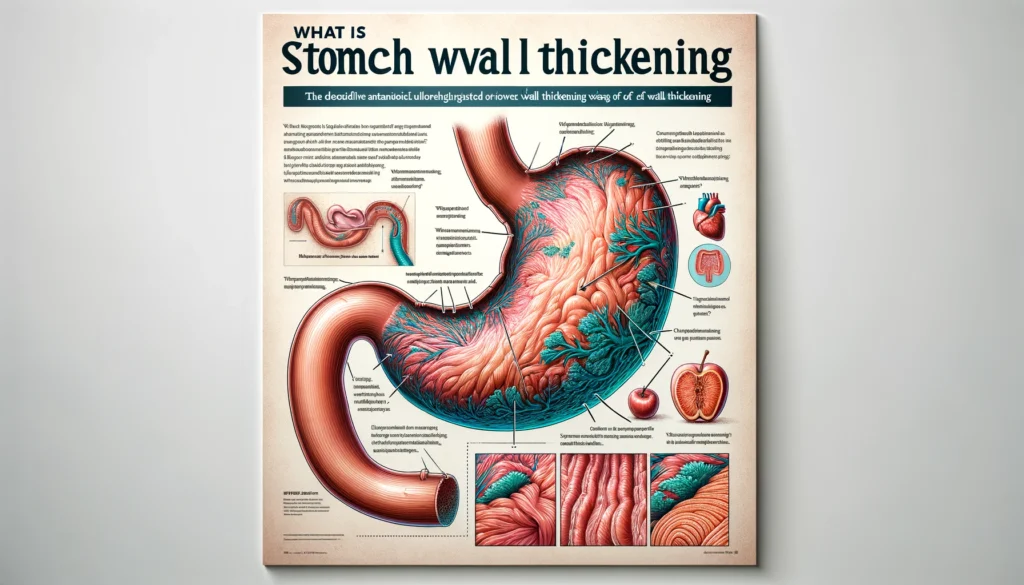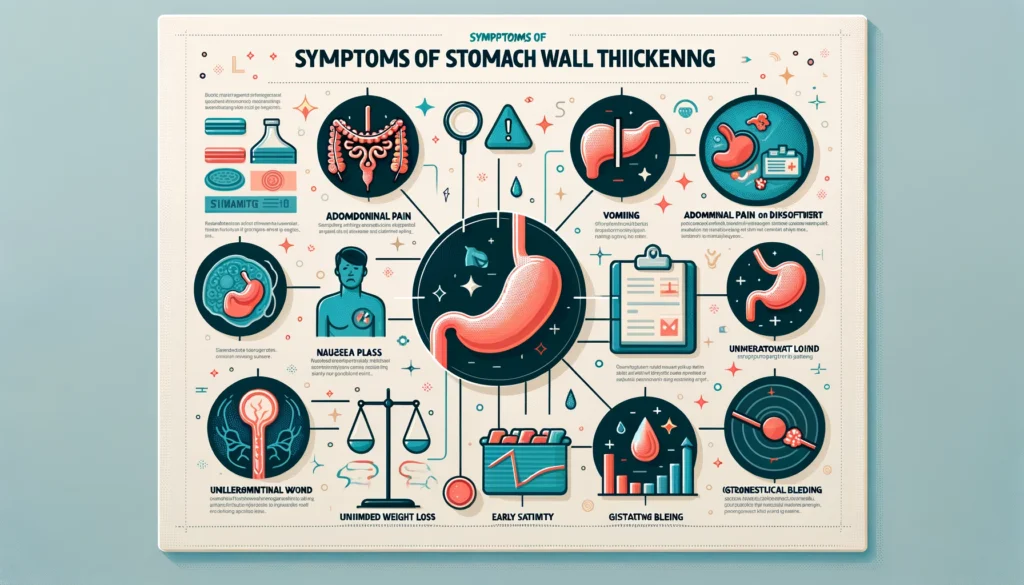Understanding the nuances of medical conditions related to the stomach, such as the thickening of its walls, is crucial for early detection, accurate diagnosis, and effective treatment.
This article delves into the significance of stomach wall thickening, exploring its causes, symptoms, diagnosis, and treatment options, with a particular focus on its association with cancer.
Table of Contents
Introduction to Stomach Wall Thickening
Understanding the complexities of the stomach—a key muscular organ vital for digestion—requires a deep dive into its anatomy and the conditions that may afflict it. One such condition that raises concern is the thickening of its wall.
This increase in thickness, particularly of the muscular layers, can be detected through advanced imaging techniques, such as ultrasound, CT scans, and MRI. Drawing from my personal journey in the medical field, this exploration into stomach wall thickening sheds light on its significance, debunking the myth that it invariably points to cancer.
While the presence of a thicker stomach wall can be alarming, it is essential to understand that various factors contribute to this phenomenon, and not all indicate malignancy. The goal here is to provide a nuanced perspective, informed by years of studying and observing how such conditions manifest and are interpreted in clinical settings.

Understanding Gastric Wall Anatomy
Drawing from my years of experience in medical writing and a deep personal journey through gastrointestinal health, I’ve come to appreciate the nuanced structure of the stomach wall.
Comprised of several layers—including the mucosa, submucosa, muscularis propria, and serosa—each plays a pivotal role in the stomach’s overall function and ability to process food. When we discuss the thickening of these layers, it’s crucial to approach the subject with a balanced perspective. While such changes can indeed signal concerning conditions, including cancer, they can also be indicative of less severe issues such as inflammation or infections.
The key to differentiating between these possibilities lies in understanding the specific characteristics and functions of the stomach’s anatomy. Through careful examination and a comprehensive analysis of symptoms, healthcare professionals can determine the underlying cause of wall thickening, emphasizing the importance of specialized knowledge and personal experience in diagnosing and treating gastrointestinal conditions.
Causes of Stomach Wall Thickening
Stomach wall thickening can result from a variety of conditions, ranging from benign to potentially malignant.
Benign Causes
- Gastritis: Inflammation of the stomach lining, often due to infection, chronic use of NSAIDs, or alcohol consumption.
- Peptic Ulcers: Open sores on the inner lining of the stomach.
- Gastric Polyps: Noncancerous growths on the lining of the stomach.
Malignant Causes
- Gastric Cancer: A type of cancer that begins in the stomach lining.
- Lymphoma: Cancer that originates in the lymphatic system and can affect the stomach.
- Gastrointestinal Stromal Tumors (GISTs): Rare tumors that start in the stomach’s muscle or connective tissue.

Understanding Symptoms and Complications of Stomach Wall Thickening
The presence of stomach wall thickening often manifests a spectrum of symptoms, pointing to a range of underlying causes. This condition, which can range from benign to more serious conditions, necessitates a thorough examination and diagnosis. Drawing from my experience, I’ve seen how this complexity demands that medical professionals tailor an effective treatment plan that delves into the potential complications associated with each unique case.
This approach not only ensures that each patient receives the care they need but also highlights the importance of recognizing the vast array of conditions that stomach wall thickening can indicate. From inflammation and infection to the more alarming possibility of cancer, the variation in potential diagnoses underscores the critical need for personalized healthcare strategies.
Symptoms of Stomach Wall Thickening
Abdominal Pain or Discomfort
One of the most common symptoms, abdominal pain or discomfort, can range from mild to severe and may be persistent or intermittent. The nature of the pain—sharp, dull, cramping, or burning—can offer clues about the underlying condition.
Nausea or Vomiting
Frequent nausea or vomiting is another significant symptom that can interfere with daily life and lead to dehydration and nutritional deficiencies if not addressed.
Unintended Weight Loss
Unexplained weight loss, especially if significant, is a concerning symptom that may indicate a more serious underlying condition, such as cancer. It often occurs because the thickening of the stomach wall affects the stomach’s ability to hold and digest food properly.
Early Satiety
Patients may experience a sensation of being full after eating only a small amount of food. This symptom, known as early satiety, can lead to decreased appetite and weight loss over time.
Gastrointestinal Bleeding
Gastrointestinal bleeding might manifest as blood in vomit or stools, which can appear red or black. This symptom is particularly concerning as it can indicate a serious underlying condition requiring immediate medical attention.

Potential Complications Arising from Stomach Wall Thickening
Obstruction
Severe thickening of the stomach wall can lead to partial or complete blockage of the stomach, preventing food from passing through the digestive tract properly. This complication can cause persistent nausea, vomiting, and severe nutritional deficiencies.
Perforation
In some cases, the thickened wall of the stomach can weaken and lead to perforation, or a hole in the stomach wall. This serious condition allows the contents of the stomach to leak into the abdominal cavity, causing peritonitis, an inflammation of the abdominal lining that can be life-threatening if not treated promptly.
Spread of Malignant Cells
If the cause of the thickening is malignant, such as in the case of stomach cancer, there is a risk that cancer cells can spread from the stomach to other parts of the body through the lymphatic system or bloodstream. This spread, known as metastasis, complicates treatment and significantly impacts prognosis.
Diagnosing Stomach Wall Thickening
A comprehensive approach is necessary for diagnosing the cause of stomach wall thickening, involving:
Imaging Studies
- Endoscopic Ultrasound (EUS): Provides detailed images of the stomach layers.
- Computed Tomography (CT) Scan: Offers cross-sectional images to detect thickening and associated abnormalities.
- Magnetic Resonance Imaging (MRI): Useful for detailed imaging of soft tissues.
Biopsy
A tissue sample may be collected during an endoscopy to examine for signs of cancer or other conditions.
Laboratory Tests
Blood tests, including those for anemia, infection, and markers of gastric cancer, can provide additional clues.
Treatment Options
Treatment varies significantly depending on the underlying cause of the thickening:
For Benign Conditions
- Medication: To treat infections or reduce acid production in the case of gastritis or ulcers.
- Dietary Changes: Avoidance of irritants like NSAIDs, alcohol, and spicy foods.
For Malignant Conditions
- Surgery: To remove the affected portion of the stomach in cases of localized cancer.
- Chemotherapy and Radiation Therapy: For reducing tumor size and managing symptoms in more advanced cases.
- Targeted Therapy: For specific types of cancer, based on the genetic makeup of the tumors.
Prevention and Early Detection
In navigating the intricate journey of preventing stomach-related illnesses and facilitating early detection of serious conditions, such as potential cancer, my personal and professional experience has illuminated a path that emphasizes the importance of regular medical check-ups and prompt attention to gastrointestinal symptoms.
Embracing healthy lifestyle choices plays a pivotal role in not just safeguarding against unforeseen health issues but also in ensuring a robust defense mechanism against the onset of serious conditions that might manifest subtly within our bodies.
The synergy between vigilant observation of bodily changes and a commitment to a proactive health regimen can significantly demystify the concerns surrounding the thickening of the stomach wall, transforming fear into informed awareness and actionable knowledge.
Check also:
Frequently asked Questions
What is thickening of the stomach wall?
Thickening of the stomach wall refers to a condition where the layers of the stomach become unusually thick. This can be detected through imaging tests such as ultrasounds, CT scans, or MRIs.
Does thickening of the stomach wall always indicate cancer?
No, thickening of the stomach wall does not always indicate cancer. While it can be a sign of gastric cancer, there are also many benign causes, such as inflammation, infection, or peptic ulcer disease.
What are the common causes of stomach wall thickening?
Common causes include gastritis (inflammation of the stomach lining), peptic ulcers, benign tumors like gastrointestinal stromal tumors (GISTs), and malignant tumors.
What symptoms might accompany thickened stomach walls?
Symptoms can vary widely depending on the underlying cause and may include abdominal pain, nausea, vomiting, weight loss, and gastrointestinal bleeding.
How is thickening of the stomach wall diagnosed?
Diagnosis typically involves imaging tests such as ultrasound, CT scan, or MRI to visualize the stomach’s structure. Additional tests, like endoscopy and biopsy, might be needed to determine the cause.
What treatments are available for thickened stomach walls?
Treatment depends on the underlying cause. For benign conditions, treatment may involve medication, dietary changes, or monitoring. For malignant causes, options include surgery, chemotherapy, radiation therapy, or targeted therapy.
Can lifestyle changes affect the thickness of the stomach wall?
In cases where the thickening is due to benign conditions like gastritis or ulcers, lifestyle changes such as diet modification, reducing alcohol consumption, and quitting smoking can have a positive impact.
Is thickening of the stomach wall a common condition?
Thickening of the stomach wall is a relatively common finding on imaging tests, but its significance varies widely depending on the context and underlying cause.
Can thickening of the stomach wall be prevented?
Preventive measures mainly target the underlying causes. For example, maintaining a healthy lifestyle, managing stress, and avoiding NSAIDs without protection can help prevent conditions like gastritis and ulcers that may lead to wall thickening.
What is the prognosis for someone with thickening of the stomach wall?
The prognosis depends on the underlying cause of the thickening. Benign conditions often have a good prognosis with appropriate treatment, while cancerous causes require more aggressive treatment and may have a more guarded prognosis.
Conclusion
Drawing from my own journey in the medical field, the discovery of a thickening of the stomach wall is undeniably alarming. Yet, it does not always signify cancer. Such a finding necessitates a detailed evaluation by healthcare professionals. This assessment typically involves a combination of history taking, physical examination, imaging studies, and possibly a biopsy. Each of these steps is essential in determining the underlying cause and formulating an appropriate treatment plan.
From a personal perspective, witnessing patients navigate this journey underscores the significance of understanding and addressing the root cause of stomach wall thickening. This approach can lead to better health outcomes and significantly improve the quality of life for those affected. In essence, while the initial discovery may be daunting, the collaborative effort between patient and healthcare team can illuminate the path toward healing and reassurance.
